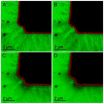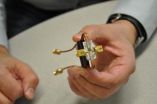Insurance status may influence transfer decisions in trauma cases, Stanford study reveals
2014-02-19
STANFORD, Calif. — Emergency rooms are less likely to transfer critically injured patients to trauma centers if they have health insurance, according to a new study by researchers at the Stanford University School of Medicine.
The counterintuitive finding suggests that insured patients are more at risk for receiving sub-optimal trauma care than uninsured patients are.
Although a majority of severely injured trauma patients are initially taken to trauma centers, at least one-third are taken to non-trauma centers. In these cases, emergency room doctors must assess the ...
HPV vaccination is associated with reduced risk of cervical lesions in Denmark
2014-02-19
A reduced risk of cervical lesions among Danish girls and women at the population level is associated with use of a quadrivalent HPV vaccine after only six years, according to a new study published February 19 in the Journal of the National Cancer Institute.
Two HPV vaccines are currently available and have proven to be highly effective against HPV16/18-associated cervical cancer. One of these vaccines, a quadrivalent vaccine, was licensed in Denmark in 2006, and it was subsequently incorporated into general childhood vaccination programs for girls free of charge and ...
Whole genome analysis, stat
2014-02-19
Although the time and cost of sequencing an entire human genome has plummeted, analyzing the resulting three billion base pairs of genetic information from a single genome can take many months.
In the journal Bioinformatics, however, a University of Chicago-based team—working with Beagle, one of the world's fastest supercomputers devoted to life sciences—reports that genome analysis can be radically accelerated. This computer, based at Argonne National Laboratory, is able to analyze 240 full genomes in about two days.
"This is a resource that can change patient management ...
Study shows in vivo endomicroscopy improves detection of Barrett's esophagus-related neoplasia
2014-02-19
DOWNERS GROVE, Ill. – February 19, 2014 – New research shows that the addition of confocal laser endomicroscopy to high-definition white-light endoscopy enables improved real-time endoscopic diagnosis of Barrett's esophagus dysplasia (neoplastic tissue) by using targeted biopsies of abnormal mucosa to reduce unnecessary mucosal biopsies and potentially reduce costs. It may also positively influence patient care by changing the plan for immediate endoscopic management. The study appears in the February issue of GIE: Gastrointestinal Endoscopy, the monthly peer-reviewed scientific ...
RXTE reveals the cloudy cores of active galaxies
2014-02-19
VIDEO:
Zoom into the cloudy heart of an active galaxy. This animation shows an artist's rendition of the cloudy structure revealed by a study of data from NASA's Rossi X-Ray Timing...
Click here for more information.
Picture a single cloud large enough to span the solar system from the sun to beyond Pluto's orbit. Now imagine many such clouds orbiting in a vast ring at the heart of a distant galaxy, occasionally dimming the X-ray light produced by the galaxy's monster black ...
NuSTAR helps untangle how stars explode
2014-02-19
For the first time, an international team of astrophysicists, including Lawrence Livermore National Laboratory scientists, have unraveled how stars blow up in supernova explosions.
Using NASA's Nuclear Spectroscopic Telescope Array (NuSTAR) – a high-energy X-ray observatory - the international collaboration created the first-ever map of radioactive material in a supernova remnant, named Cassiopeia A, or Cas A for short. The findings reveal how shock waves likely rip apart massive dying stars, and ultimately end their lives.
A supernova is the cataclysmic death of a ...
REACT clinical trial supports new approach of accelerated treatment for Crohn's disease
2014-02-19
The final results from an international clinical trial involving nearly 2,000 patients with Crohn's disease support the use of a new management strategy referred to as accelerated step-care as a best practice for the care of active Crohn's disease. The REACT (Randomized Evaluation of an Algorithm for Crohn's Treatment) study, led by Robarts Clinical Trials at Western University (London, Canada) provides valuable new insights for community gastroenterologists which should benefit patients. The results of the study will be presented at the European Crohn's and Colitis Organisation ...
ORNL microscopy system delivers real-time view of battery electrochemistry
2014-02-19
OAK RIDGE, Tenn., Feb. 19, 2014 -- Using a new microscopy method, researchers at the Department of Energy's Oak Ridge National Laboratory can image and measure electrochemical processes in batteries in real time and at nanoscale resolution.
Scientists at ORNL used a miniature electrochemical liquid cell that is placed in a transmission electron microscope to study an enigmatic phenomenon in lithium-ion batteries called the solid electrolyte interphase, or SEI, as described in a study published in Chemical Communications.
The SEI is a nanometer-scale film that forms ...
Many Texans struggling to pay for health service as Affordable Care Act is about to launch
2014-02-19
HOUSTON – (Feb. 19, 2014) – Many Texans were struggling to pay for basic health services on the eve of the launch of the Affordable Care Act's Health Insurance Marketplace, according to a report released today by Rice University's Baker Institute for Public Policy and the Episcopal Health Foundation. The report also found that even those with health insurance reported dissatisfaction with the cost and availability of services. Most Texans expect more of the same in 2014.
The Health Reform Monitoring Survey (HRMS)-Texas report is based on the HRMS, a national project that ...
Molecular aberration signals cancer
2014-02-19
Several scientists, including one at Simon Fraser University, have made a discovery that strongly links a little understood molecule, which is similar to DNA, to cancer and cancer survival.
EMBO Reports, a life sciences journal published by the European Molecular Biology Organization, has just published online the scientists' findings about small non-coding RNAs.
While RNA is known to be key to our cells' successful creation of proteins, the role of small non-coding RNAs, a newly discovered cousin of the former, has eluded scientific understanding for the most part. ...
Cell therapy shows remarkable ability to eradicate cancer in clinical study
2014-02-19
NEW YORK, February 19, 2014 — Investigators from Memorial Sloan Kettering Cancer Center have reported more encouraging news about one of the most exciting methods of cancer treatment today. The largest clinical study ever conducted to date of patients with advanced leukemia found that 88 percent achieved complete remissions after being treated with genetically modified versions of their own immune cells. The results were published today in Science Translational Medicine.
"These extraordinary results demonstrate that cell therapy is a powerful treatment for patients who ...
LGBT youth face greater cancer risks, CCNY-led study
2014-02-19
A new study led by City College of New York psychologist Margaret Rosario found that youths of same-sex orientation are more likely to engage in behaviors associated with cancer risk than heterosexuals. The peer-reviewed findings appear in the February 2014 issue of the American Journal of Public Health.
Titled "Sexual Orientation Disparities in Cancer-Related Risk Behaviors of Tobacco, Alcohol, Sexual Behaviors, and Diet and Physical Activity: Pooled Youth Risk Behavior Surveys," the study pooled YRBS (Youth Risk Behavior Survey) data from 2005 and 2007. The YRBS is ...
Using holograms to improve electronic devices
2014-02-19
RIVERSIDE, Calif. (http://www.ucr.edu) — A team of researchers from the University of California, Riverside Bourns College of Engineering and Russian Academy of Science have demonstrated a new type of holographic memory device that could provide unprecedented data storage capacity and data processing capabilities in electronic devices.
The new type of memory device uses spin waves – a collective oscillation of spins in magnetic materials – instead of the optical beams. Spin waves are advantageous because spin wave devices are compatible with the conventional electronic ...
Statistics research could build consensus around climate predictions
2014-02-19
Philadelphia, PA—Vast amounts of data related to climate change are being compiled by research groups all over the world. Data from these many and various sources results in different climate projections; hence, the need arises to combine information across data sets to arrive at a consensus regarding future climate estimates.
In a paper published last December in the SIAM Journal on Uncertainty Quantification, authors Matthew Heaton, Tamara Greasby, and Stephan Sain propose a statistical hierarchical Bayesian model that consolidates climate change information ...
Smellizing -- imagining a product's smell -- increases consumer desire, study finds
2014-02-19
Seeing is believing, but smellizing – a new term for prompting consumers to imagine the smell of a product – could be the next step toward more effective advertising.
Researchers came to this conclusion through four studies of products most of us would like to smellize: cookies and cake.
Professor of Marketing Maureen Morrin of Temple University's Fox School of Business co-authored Smellizing Cookies and Salivating: A Focus on Olfactory Imagery to examine the impact imagining what a food smells like would have on consumer behavior.
"Before we started this project, ...
Discovery by Baylor University researchers sheds new light on the habitat of early apes
2014-02-19
WACO, Texas (Feb. 18, 2014)-- Baylor University researchers, in collaboration with an international team of scientists, have discovered definitive evidence of the environment inhabited by the early ape Proconsul on Rusinga Island, Kenya. The groundbreaking discovery provides additional information that will help scientists understand and interpret the connection between habitat preferences and the early diversification of the ape-human lineage.
Their research findings--published this month in Nature Communications--demonstrate that Proconsul and its primate relative Dendropithecus ...
Graduate student makes major discovery about seal evolution
2014-02-19
Ottawa, February, 19, 2014—In the world of science, one of the most exciting things a researcher can do is pin down an answer to a widely asked question. This experience came early for Carleton University graduate Thomas Cullen, who made a discovery about pinnipeds—the suborder that makes up seals, sea lions and walruses—while doing research for his Master's degree under the supervision of Canadian Museum of Nature palaeontologist Dr. Natalia Rybczynski.
His discovery, published the journal Evolution, relates to sexual dimorphism (a large variance in size between males ...
Huntington's disease: Hot on the trail of misfolded proteins' toxic modus operandi
2014-02-19
WASHINGTON D.C. Feb. 19, 2014 -- Proteins are the workhorses of the cell, and their correctly folded three-dimensional structures are critical to cellular functions. Misfolded structures often fail to properly perform these vital jobs, leading to cellular stress and devastating neurodegenerative disorders such as Alzheimer's, Parkinson's and Huntington's disease.
In comparison with the mysteries of Alzheimer's or Parkinson's disease, Huntington's disease has a seemingly simple culprit: an expansion in the polyglutamine (polyQ) tract of a protein called "Huntingtin" (Htt). ...
Rutgers scientists identify structure of virus that could lead to hepatitis C vaccine
2014-02-19
Rutgers University scientists have determined the structure of a hepatitis C surface protein, a finding that could assist in the development of a vaccine to halt the spread of the the deadly disease that has infected 3.2 million Americans.
Joseph Marcotrigiano, associate professor of chemistry and chemical biology, says this new research – published online today in Nature – describes an outer region of hepatitis C that enables the virus to evade the body's natural immune system response, causing persistent, chronic infection.
Hepatitis C is constantly mutating, allowing ...
The ups and downs of early atmospheric oxygen
2014-02-19
RIVERSIDE, Calif. — A team of biogeochemists at the University of California, Riverside, give us a nontraditional way of thinking about the earliest accumulation of oxygen in the atmosphere, arguably the most important biological event in Earth history.
A general consensus asserts that appreciable oxygen first accumulated in Earth's atmosphere around 2.3 billion years ago during the so-called Great Oxidation Event (GOE). However, a new picture is emerging: Oxygen production by photosynthetic cyanobacteria may have initiated as early as 3 billion years ago, with oxygen ...
NuSTAR telescope takes first peek into core of supernova
2014-02-19
Astronomers for the first time have peered into the heart of an exploding star in the final minutes of its existence.
The feat is one of the primary goals of NASA's NuSTAR mission, launched in June 2012 to measure high-energy X-ray emissions from exploding stars, or supernovae, and black holes, including the massive black hole at the center of our Milky Way Galaxy.
The NuSTAR team reported in this week's issue of the journal Nature the first map of titanium thrown out from the core of a star that exploded in 1671. That explosion produced the beautiful supernova remnant ...
Managed honeybees linked to new diseases in wild bees
2014-02-19
Diseases that are common in managed honeybee colonies are now widespread in the UK's wild bumblebees, according to research published in Nature. The study suggests that some diseases are being driven into wild bumblebee populations from managed honeybees.
Dr Matthias Fürst and Professor Mark Brown from Royal Holloway University of London (who worked in collaboration with Dr Dino McMahon and Professor Robert Paxton at Queen's University Belfast, and Professor Juliet Osborne working at Rothamsted Research and the University of Exeter) say the research provides vital information ...
Gene sequencing project discovers common driver of a childhood brain tumor
2014-02-19
(MEMPHIS, Tenn. – February 19, 2014) The St. Jude Children's Research Hospital-Washington University Pediatric Cancer Genome Project has identified the most common genetic alteration ever reported in the brain tumor ependymoma and evidence that the alteration drives tumor development. The research appears February 19 as an advanced online publication in the scientific journal Nature.
The results provide a foundation for new research to improve diagnosis and treatment of ependymoma, the third most common brain tumor in children. St. Jude has begun work to translate the ...
Managing chronic bone and joint pain
2014-02-19
ROSEMONT, Ill.—Musculoskeletal pain of the bone, joint and muscles is one of the most common reasons for primary care visits in the United States. According to a literature review appearing in a recent issue of the Journal of the American Academy of Orthopaedic Surgeons (JAAOS), chronic pain, or pain that persists beyond an expected period of healing, is estimated to affect 100 million Americans.
The majority of chronic pain complaints concern the musculoskeletal system, but they also include headaches and abdominal pain. "As orthopaedic surgeons, we are experts in the ...
Blood pressure medications given right after stroke not beneficial, study finds
2014-02-19
MAYWOOD, IL – A major study has found that giving stroke patients medications to lower their blood pressure during the first 48 hours after a stroke does not reduce the likelihood of death or major disability.
The study is published in the Journal of the American Medical Association.
At least 25 percent of the population has high blood pressure, which greatly increases the risk of stroke. Lowering blood pressure has been shown to reduce the risk of stroke. The study investigated whether there also would be a benefit to lowering blood pressure immediately after a stroke.
The ...
[1] ... [3867]
[3868]
[3869]
[3870]
[3871]
[3872]
[3873]
[3874]
3875
[3876]
[3877]
[3878]
[3879]
[3880]
[3881]
[3882]
[3883]
... [8708]
Press-News.org - Free Press Release Distribution service.












